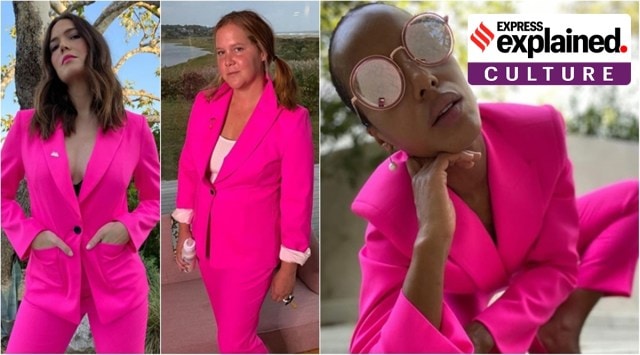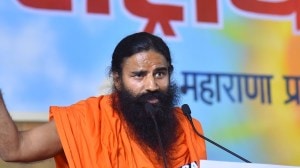- India
- International
Explained: The politics of the pink pantsuit
Why are celebrities posting selfies in pink suits on social media. Is this the first time that pink has been used as a political colour?
 From left: Mandy Moore, Amy Schumer and Kerry Washington. (Source: Instagram)
From left: Mandy Moore, Amy Schumer and Kerry Washington. (Source: Instagram)Last week, actor Kerry Washington posted a selfie in a pop pink pantsuit on social media, with the caption “Gladiator in a (pink) suit”. The actor, who rounded off her look with pink pumps, is part of a digital campaign in the run-up to the American elections on November 3. It’s got other celebrities sporting the same attire, making the “power pink” a political statement in 2020.
Why are celebrities posting selfies in pink suits on social media?
With the hashtag #AmbitionSuitsYou, the social media campaign means to mobilise American women to vote. Celebrities have personalised a pink suit in different ways, but with the collective intention of supporting women candidates running for office. Their posts ran with a common caption: “Women are the most powerful force in America. We are the majority of people and voters in this country and we will determine the outcome of this election.”
The fuschia pantsuits on celebrities, such as Kerry Washington, Zoe Saldhana, Mandy Moore and Amy Schumer, are from a special “election collection” by workwear brand Argent. A part of the sale proceeds will go to Supermajority, a group that aims to increase women’s electoral participation, and was founded by members of Planned Parenthood, Black Lives Matter and the National Domestic Workers Alliance.
Also in Explained: Why winning Florida is crucial for Donald Trump in the US Election 2020
Is this the first time that pink has been used as a political colour?
No. Since the 1990s, if not earlier, feminist and queer movements have reinvented the gendered colour into a political choice. Historically, for much of the 18th century in the West, pink was seen as an “active” colour and preferred for elite boys, rather than girls. Over time, dress manufacturers started colour coding pink for girls and blue for boys to increase sales of apparel for infants.

Earlier seen as “girly” (meaning, feminine and weak), pink was subverted as a statement of strength and as one of the best ways to push against gender stereotyping. The use of pink ribbons for breast cancer awareness in 1992 is one of the earliest such examples.
Roxane Gay, author of Bad Feminist: Essays (2014), wrote in her book, “Pink is my favourite colour. I used to say my favourite colour was black to be cool, but it is pink – all shades of pink.” Activist Scarlett Curtis’ 2018 book was even titled ‘Feminists Don’t Wear Pink and Other Lies’. There are other instances, too, such as the pink “pussyhats” used during the 2017 Women’s March in the USA, which connected the colour to the “feminine” craft of knitting. 📣 Follow Express Explained on Telegram
Is pink political in India too?
In India, too, pink is strongly associated with women’s movements. The Gulabi Gang from Uttar Pradesh, which works to end violence against women, is instantly recognisable by the pop pink saris its members wear. The Pink Chaddi Campaign of 2009 was a protest in which people sent pink underwear to Pramod Muthalik of the Sri Ram Sena.
Have female politicians in America embraced pink pantsuits?
Hillary Clinton shared pictures of the celebrities in pink pantsuits, stating, “Love these power pantsuits, and the powerful women wearing them.” The American politician, who is synonymous with pantsuits, has worn several shades of pink, and often been criticised for the sartorial choice. In April 2019, Alexandria Ocasio-Cortez wore a pink pantsuit when the Congress passed the Violence Against Women Act, and tweeted saying, “On Capitol Hill we wear pink”.
More Explained
EXPRESS OPINION
Apr 16: Latest News
- 01
- 02
- 03
- 04
- 05








































